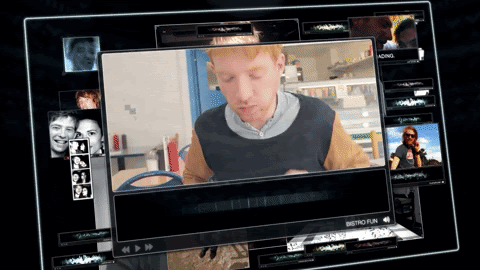Be Right Back is a story about capitalizing (so you know Volti’s down) on the vulnerability of the grieving.
Recap
After Ash dies, Martha is involuntarily added to a “beta” service that, initially, uses Ash’s online presence to train a chatbot. While Ash’s mannerisms and bad jokes are present, it’s not enough to fill the void, so robo-Ash presents Martha with its first upsell: literally speaking.

This tier requires granting access to videos so robo-Ash can sample Ash’s voice. However, as seen above, the software is not only sampling Ash’s voice but also his face. This invasion of privacy enables robo-Ash to successfully upsell Martha on an “experimental” and “not cheap” next level: a physical body à la the 2001 movie A.I.

While excited at first, Martha slowly grows disillusioned, from robo-Ash missing a mole on its body to its not closing its eyes while “sleeping” to its being too attentive to its inability to argue to its obviously fake breathing, to, finally, its calling Ash’s favorite song cheesy.
I got serious Babadook vibes from the ending of this episode.

Martha couldn’t get rid of robo-Ash and locked it away in the attic but still visits it regularly with her kid. This is almost the exact same ending for The Babadook except that the Babadook ends up in the basement and the mom DOESN’T let her kid see it. Sorry for spoilers, but it’s been 7+ years. The monster as a metaphor for grief and as something you live with, not defeat, resonates with me.
Some criticisms
Robo-Ash’s voice cutting out for dramatic effect during its birth was annoying because there’s no way it exists as a single instance. It admitted to being in “the Cloud,” which means it’s highly available and should have been able to continue talking while replicating into the physical bot.
It also really bugged me that Martha never really lost anything to pay for any of the incarnations of robo-Ash. At the end of the episode she has the house (fully renovated), she has a healthy kid, and she still has a fully-functioning physical robo-Ash. Granted Martha seems to be the only guest for her daughter’s birthday, which may indicate she never reintegrated with her family/society, but that’s a stretch.
What to talk about
While this episode touches on plenty of interesting topics, like how the photos we post tend to be flattering, the predatory pushing practices of “free trials” and the illusion of consent in digital spaces, I think the most actionable issue to touch on is what happens to your online presence when you die—also because that actually somewhat ties in with some of the reading (Volti 277).
Social media after death
If you’re significant enough, you could end up with an account that tweets out your quotes:
"Do the best you can until you know better. Then when you know better, do better.” #MayaAngelou pic.twitter.com/zd589Lqaw0
— Maya Angelou (@DrMayaAngelou) June 3, 2021
Or you could see yourself posthumously promoting your album:
#EXODUSALBUM OUT NOW #BATHSALTS https://t.co/7WjArkvysk pic.twitter.com/AVqcOU26F5
— DMX (@DMX) May 29, 2021
But for the non-celebrity, there’s basically three possibilities:
- Your account exists in perpetuity.
- Your account is memorialized.
- Your account is deleted.
For more information, read the relevant help articles on Twitter, Facebook, and Instagram, but essentially, your accounts will just exist unless someone reports you as dead, which requires your death certificate as well as other personally identifiable information (PII). If someone does complete that process, your account will either be memorialized (locked down from future changes but still available) or deleted. However, in no circumstance does any company grant someone else access to your account.
I think it’s ridiculous to make surviving family members navigate this bureaucratic nightmare of corporate paperwork. I use a password manager for all of my passwords, so I just need to make sure that info gets to someone else. Letting someone who isn’t me log into my accounts probably violates terms and conditions, but who cares? I’m already dead in this scenario, and my family shouldn’t have to give up their right to privacy to clean up or memorialize my accounts. If anything, this episode is a good reminder for me to write a will and find an executor.
Tech and the grieving process
Beyond memorialized accounts, tech is “disrupting” the grieving process.
From exes to dead pets, dead names to miscarriages, features like On this day or Memories make “hiding picture frames in the attic” to compartmentalize grief increasingly impossible. Time can sour once happy memories. THANKFULLY big tech isn’t aware enough to identify those changes, but I’m sure it’s trying.
At the same time, the disruptions may not all be for the worse.
I’m friends with at least three dead people on Facebook. Only one is memorialized. At first I thought it was macabre, but after a little scrolling I realized it’s really no more macabre than a Shinto tamaya or burning a letter to Heaven. In fact, the pseudo-public nature lets other people share anecdotes and react to show support, which is huge because death, rather “passing away,” isn’t something Western folks like to talk about. This comes in stark contrast to the Dear Evan Hansen-equse narcissism of appropriating tragedy.
No one deserves to be forgotten
No one deserves to disappear
While these lines are sung for Connor, each student is really singing about their own desire to be remembered, but social media’s effect on collective and performative grieving is for another post.
Discussion question
What do you want to happen to your social media accounts after you die?